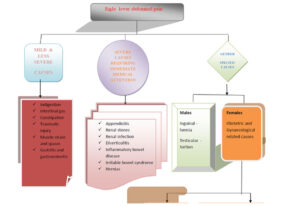Urinary tract infections (UTI) are the second most bacterial disease and the most common bacterial infection in women, with at least one-third of women developing a urinary tract infection before the age of 24. During their lifetime more than half of the women will have a UTI and up to 50% of these will have another infection within a year. Pregnant women have a higher risk of urinary tract infections. UTIs complicate up to 20% of pregnancies and are responsible for 10% of all antepartum admissions.
SYMPTOMS
- Strong-smell of urine
- A strong, persistent urge to urinate
- Passing frequent, small amounts of urine
- red, bright pink, or cola-colored urine
- Urine that appears cloudy
- A burning sensation when urinating
- blood in the urine
- Pelvic pain, in women around the area of the pubic bone
- Stinging pain in the urethral area
- High frequency of urination at night
- Delay or difficulty in initiating urine
- A large amount of urine as comparing with normal days
- less volume of urine as comparing with normal days
- Involuntary urination
TYPES OF URINARY TRACT INFECTIONS
Several classification systems can be used for UTIs. For example, a UTI can be broadly classified as an upper or lower urinary tract infection according to its location within the urinary system Infection of the upper urinary tract (involves renal parenchyma, pelvis, and ureters) typically causes fever, chills, flank pain, etc. whereas a UTI confined to the lower urinary tract does not usually have systemic manifestation. For eg pyelonephritis, cystitis, urethritis
Kidneys (acute pyelonephritis)- Symptoms
- Upper back and side (flank) pain
- High fever
- Shaking and chills
- Nausea
- Vomiting
Bladder (cystitis)
- Pelvic pressure
- Lower abdomen discomfort
- Frequent, painful urination
- Blood in urine Urethra (urethritis)
- Burning with urination
- Discharge
CAUSES
Urinary tract infections generally a result of bacteria enter the urinary tract through the urethra and start to multiply within the bladder.
Factors increasing urinary stasis
- stone, the tumor of the urinary tract, urethral stricture
- fibrosis
- Urinary retention
- Renal impairment
Foreign bodies
- Urinary tract calculi
- Use of catheters
Risk factors
Urinary tract infections are one of the most common bacterial infection in women, and many women experience more than one infection during their lifetimes. Risk factors of urinary tract infections include:
- Female anatomy- A woman has a shorter urethral duct than a man does, which reduces the gap that bacteria must travel to enter the bladder.
- Sexual activity- Women who are sexually active tend to possess more urinary tract infections than do women who are not sexually active. Having a new sexual partner additionally raises your risk.
- Certain types of contraception- Women who use diaphragms for contraception may be at greater risk, furthermore women who use
spermicidal agents. - Menopause- After menopause, a decline in circulating sex hormone estrogen may make changes in the urinary tract that make you at more risk of infection.
Other risk factors for UTIs include:
- • Urinary tract abnormalities- New born with urinary tract abnormalities have unable to allow urine to leave the body normally or urine may back up in the urethra have a greater risk of urinary tract infections
- Blockages in the urinary tract- Kidney stones or any type of block can trap urine in the bladder and raise the chance of UTIs.
- A reduced immune system- Diabetes and other diseases that impair the immune system — the body’s defense against germs — can increase the risk of UTIs.
- Long term Catheter use- People who are unable urinate on their own and use a tube (catheter) to urinate have a greater risk of UTIs. This may include bedridden people, people with kidney problems that make it difficult to control their ability to urinate, and patients who are paralyzed.
- A recent urinary procedure- A recent surgery to the urinary system or an examination of your urinary tract that involves medical instruments can both increase your chances of developing a urinary tract infection.
DIAGNOSTIC TESTS
- Urine analysis
- Blood tests
- Renal ultrasound
- CT Scan
- MRI
- NEPHRITOGRAM
MEDICAL TREATMENT
- A minute dose of antibiotics for a longer time will aid to prevent the recurrence of infections
- A lower dose of an antibiotic after sexual intercourse, which helps to slow down the infection
- Antibiotics should take for a few days and every time symptoms appear
- A non-antibiotic prophylaxis treatment
After antibiotic treatment, repeat urinalysis
COMPLICATIONS
- Repeated infections, especially in women who experience two or more UTIs in the past six-month period or four or more within a year.
- Permanent nephrological problems from an acute or chronic kidney infection due to an untreated urinary tract infection
- pregnant women have increased risk of delivering low birth weight or premature infants.
- Urethral shortening (stricture) in men from repeated urethritis, previously seen with gonococcal urethritis.
- Sepsis, a potentially critical complication of an infection, especially if the infection works its way up from your urinary tract to your kidneys.
PREVENTION
You can take these steps to shorten your risk of urinary tract infections:
- Drink plenty of water. Drinking large amount of water in-order to helps dilute your urine and ensures that you will urinate more often and permitting bacteria to be flushed from your urinary tract before infection will begin.
- Drink fruit juice, especially cranberry juice. Although studies are not conclusive that cranberry juice prevents UTIs, it is seemingly not harmful.
- Wipe from front to back. Doing therefore when urinating and after a bowel movement helps prevent bacteria in the anal region from entering the vagina and urethra.
- Empty your bladder soon after sexual intercourse and drink a full glass of water to flush out bacteria.
- Avoid using feminine hygiene sprays, scented douches, and scented bath products; they will reduce the ph level in the vagina and increase the risk of urinary tract infection
- Change your contraceptive method like Diaphragms, or unlubricated or spermicide-treated condoms, can all lead to bacterial growth.
- Clean your genital area before sex and after sex




